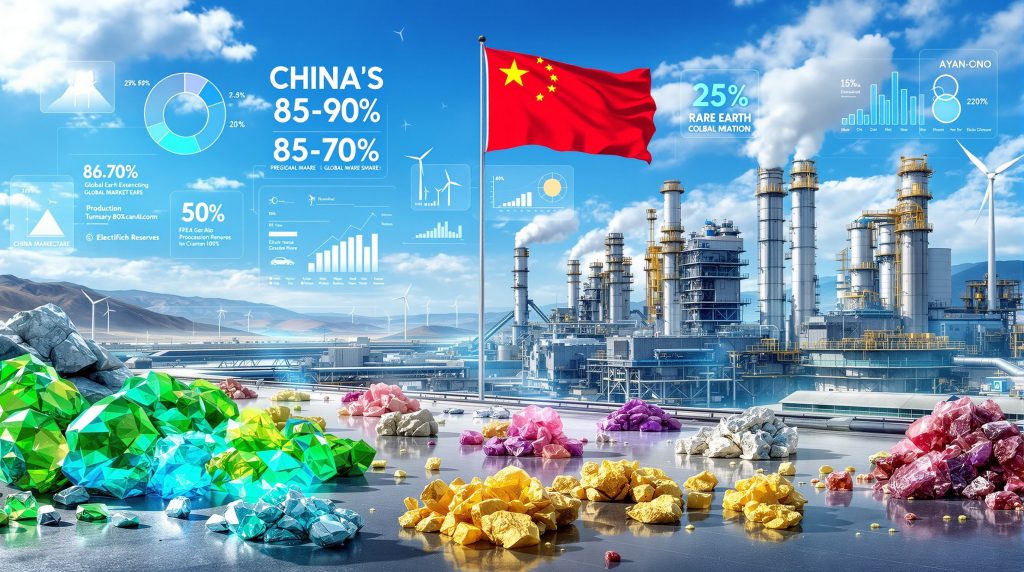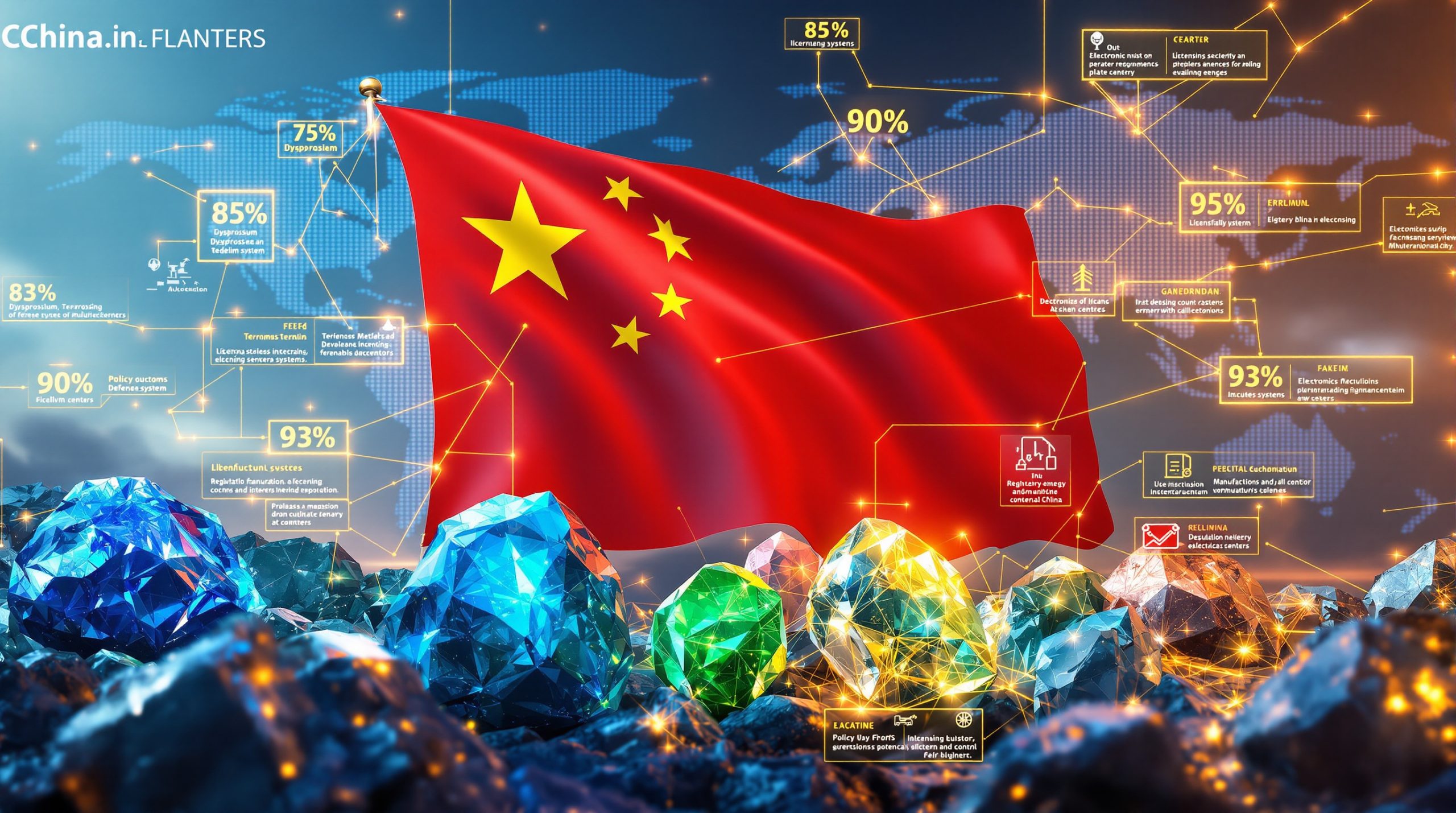China's Strategic Foundation: The Geography of Global Control
China's rare earth dominance stems from an extraordinary geological advantage combined with decades of strategic industrial development. The nation controls approximately 85-90% of global rare earth refining capacity while holding an estimated 44-50 million metric tons of rare earth oxide reserves, representing the world's most concentrated supply chain control in any critical mineral sector. Furthermore, this control extends far beyond simple extraction, creating dependencies that influence global technology markets and geopolitical relationships.
The foundation of this dominance lies in Inner Mongolia's Bayan Obo Mining District, which contains roughly 83% of China's total rare earth reserves. This massive deposit serves as the cornerstone of Beijing's mineral empire, producing the majority of light rare earth elements that power everything from wind turbines to smartphone displays.
China's Rare Earth Control Structure:
• 69-70% of global mining operations under Chinese control
• 90% of processing and refining infrastructure concentrated in China
• State-regulated production quotas managing global supply dynamics
• Integrated supply chain from extraction to finished magnet production
This geographic concentration creates what industry analysts describe as structural dependency that transcends typical trade relationships. Unlike conventional commodities, rare earth processing requires sophisticated separation technologies that China has perfected over multiple decades of focused investment.
The Industrial Architecture Behind Beijing's Mineral Empire
China's transformation from a rare earth exporter to the world's dominant processor represents one of the most successful examples of strategic industrial policy in modern history. While Western nations focused on environmental regulations and cost optimisation, Beijing systematically built comprehensive processing infrastructure that competitors struggle to replicate.
The technical complexity of rare earth separation cannot be overstated. Converting mixed rare earth ore into purified individual elements requires mastering multi-stage solvent extraction systems, precise pH and temperature controls, and specialised equipment for handling radioactive materials. Chinese firms like Baotou Steel Rare Earth and Shenghe Resources have spent decades optimising these processes, creating barriers to entry that extend far beyond simple mining operations.
China's Processing Advantage by Numbers:
| Processing Stage | Chinese Market Share | Global Capacity |
|---|---|---|
| Initial Separation | 95% | 185,000 tonnes/year |
| Oxide Production | 87% | 155,000 tonnes/year |
| Metal Alloy Production | 92% | 145,000 tonnes/year |
| Magnet Manufacturing | 89% | 85,000 tonnes/year |
This integrated approach allows Chinese producers to maintain cost advantages and technical expertise that new market entrants find nearly impossible to match. The investment required to establish competitive processing facilities ranges from $500 million to $2 billion, with technical expertise development taking 5-10 years for operational competency.
In addition, this dominance has created ripple effects across the broader mining industry evolution, where companies worldwide must navigate the complexities of securing reliable rare earth supplies.
Beijing's Export Control Arsenal: Chemistry as Diplomacy
China has increasingly weaponised its rare earth dominance through sophisticated export control mechanisms that function as diplomatic pressure tools. Rather than crude supply cutoffs, Beijing employs what industry insiders call tempo control, using licensing delays and regulatory adjustments to signal displeasure with trading partners while maintaining plausible deniability.
The most notable example occurred during the 2010 territorial dispute with Japan, when Chinese rare earth exports to Japan dropped dramatically through administrative delays rather than formal embargoes. Moreover, recent developments showcase how the China export controls example demonstrates Beijing's refined approach to using mineral resources as diplomatic leverage.
Recent Export Control Applications:
• 2019-2020: Licensing delays targeting U.S. firms during trade war negotiations
• 2021: Processing technology restrictions limiting equipment exports
• 2023: Expanded controls covering gallium and germanium alongside traditional rare earths
• 2024-2025: Refined administrative procedures creating unpredictable supply timelines
These measures demonstrate how China has evolved beyond simple resource nationalism toward sophisticated supply chain manipulation. Each delay hardens Beijing's strategic position while Western firms draft press releases about supply diversification that remain largely aspirational. Consequently, the US-China trade war impact continues to reverberate through global markets, particularly affecting sectors dependent on rare earth elements.
America's Embryonic Response: Progress Versus Propaganda
U.S. efforts to reduce rare earth dependency have produced modest milestones amid triumphant rhetoric that obscures the scale of the challenge. MP Materials' Fort Worth facility represents the most significant domestic progress, establishing the first U.S. rare earth magnet production line in decades. However, this facility still relies on Chinese-processed materials, highlighting the persistent dependency on foreign supply chains.
The Lynas Texas refinery partnership with Australian producer Lynas Corporation offers another potential breakthrough, yet the facility remains under construction while Chinese competitors expand capacity. Industry experts note that these projects, while symbolically important, address only a fraction of U.S. rare earth consumption needs.
Current U.S. Supply Chain Initiatives:
• MP Materials: Domestic magnet production using Chinese-processed materials
• Lynas Partnership: Future processing capacity contingent on completion timeline
• Department of Defense: Strategic stockpiling programmes of limited commercial scale
• Apple Recycling: $500 million investment in urban mining technology development
The uncomfortable reality remains that neither U.S. political party has fundamentally altered America's mineral dependency. Furthermore, North American mining trends indicate continued challenges in developing domestic processing capabilities, despite increased investment rhetoric.
Policy symbolism cannot substitute for the unglamorous investment in separation chemistry, metallurgical expertise, and refining infrastructure that defines true supply chain sovereignty.
The Technical Barriers: Why Chemistry Beats Charisma
Creating competitive rare earth processing capabilities requires mastering some of the most complex industrial chemistry processes known to modern manufacturing. The separation of individual rare earth elements from mixed ore involves sophisticated solvent extraction techniques that Chinese firms have refined through decades of operational experience.
Critical Processing Requirements:
• Separation Chemistry: Multi-stage extraction using specialised organic solvents
• Purity Standards: Achieving 99.9%+ purity for high-tech applications
• Radioactive Handling: Managing thorium and uranium byproducts safely
• Waste Treatment: Processing massive volumes of acidic waste streams
• Quality Control: Maintaining consistent specifications across batch production
The economic barriers compound these technical challenges. Environmental compliance costs often represent 20-30% of total project costs, while market volatility can eliminate profit margins overnight. Chinese producers benefit from established supply relationships, optimised processes, and government support that new entrants struggle to replicate.
Perhaps most significantly, the skilled workforce required for rare earth processing cannot be trained quickly. Chinese facilities employ chemists, metallurgists, and process engineers with specialised knowledge developed over career-spanning tenures. This human capital advantage may prove more durable than any technological breakthrough.
However, research from the Centre for Strategic and International Studies indicates that "China's new rare earth restrictions could significantly impact defence supply chains", highlighting the strategic vulnerabilities created by this technical dependency.
Global Supply Chain Implications: Beyond Trade War Theatre
China's rare earth dominance extends influence across virtually every high-technology sector, creating dependencies that transcend traditional trade relationships. The global transition toward renewable energy technologies has intensified these dynamics, with wind turbine generators and electric vehicle motors requiring high-performance permanent magnets produced almost exclusively using Chinese-processed materials.
Strategic Applications by Element:
| Rare Earth Element | Primary Application | Chinese Processing Share |
|---|---|---|
| Neodymium | EV motors, wind turbines | 87% |
| Dysprosium | High-temperature magnets | 95% |
| Terbium | LED phosphors | 92% |
| Europium | Display screens | 89% |
| Yttrium | Medical lasers | 91% |
The implications extend beyond commercial considerations into national security domains. Advanced defence systems, satellite communications, and precision-guided weaponry all depend on rare earth elements processed through Chinese-controlled supply chains. This dependency creates vulnerabilities that traditional military planning struggles to address.
Consequently, the importance of critical minerals in energy transition has become increasingly apparent as nations seek to balance environmental goals with supply chain security.
Industry projections suggest 300-400% growth in electric vehicle magnet demand through 2035, alongside 200-250% increases in wind turbine requirements. Meeting this demand through non-Chinese supply chains would require processing capacity expansion that currently exists only on paper.
Additionally, analysis from Mining.com.au suggests that "while new competitors are emerging globally, the timeline for meaningful diversification remains measured in decades rather than years".
The Geopolitical Endgame: Patience Versus Politics
Beijing's rare earth strategy exemplifies long-term thinking that outlasts political cycles in democratic nations. While Western leaders focus on quarterly earnings and election timelines, Chinese policymakers have systematically built industrial capabilities that compound competitive advantages over decades.
Each trade truce or diplomatic détente provides China additional time to expand capacity while Western supply chain initiatives remain embryonic. Baotou Steel Rare Earth and Rising Nonferrous continue expanding refining operations while American firms navigate environmental reviews and permitting processes.
China's Strategic Timeline Advantage:
• 1980s-1990s: Infrastructure investment during Western deindustrialisation
• 2000s-2010s: Capacity expansion while competitors exited markets
• 2010s-2020s: Export control development and diplomatic leverage testing
• 2020s-2030s: Advanced processing technology and integrated supply chain optimisation
This patient approach has transformed geological fortune into geopolitical leverage that defines power relationships in the 21st century. China isn't simply exporting metals; it's exporting dependency while importing strategic autonomy.
What Makes China's Rare Earth Strategy So Effective?
The lesson extends beyond rare earths to encompass broader questions of industrial policy and national competitiveness. Until Western nations fund the unglamorous science of separation chemistry and metallurgical infrastructure, they will remain price takers in markets where technical mastery, not diplomatic rhetoric, determines outcomes.
Market Reality Check: Despite years of supply diversification rhetoric, global dependence on Chinese rare earth processing has actually increased as demand growth outpaces alternative capacity development, creating deeper structural vulnerabilities across technology supply chains.
The rare earth sector reveals how control over seemingly obscure industrial materials can reshape international relations, demonstrating that in modern geopolitics, mastery of the periodic table may matter more than mastery of traditional diplomatic arts.
Will China's Rare Earth Dominance Continue?
In conclusion, China's rare earth dominance represents a masterclass in strategic industrial policy that combines geological advantages with decades of focused investment. While Western nations pursue supply diversification initiatives, the technical barriers, financial requirements, and time scales involved suggest that Chinese control will persist for the foreseeable future. The implications extend far beyond commodity markets, influencing everything from renewable energy deployment to national security planning across the developed world.
Looking for Exposure to Critical Minerals and Strategic Resources?
Discovery Alert's proprietary Discovery IQ model identifies significant ASX mineral discoveries in real-time, including companies involved in critical minerals and strategic resources that could reshape global supply chains. Explore how historic mineral discoveries have generated substantial returns for early investors, then begin your 30-day free trial today to position yourself ahead of market-moving announcements.




